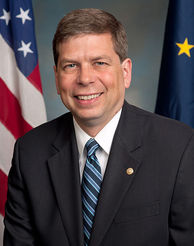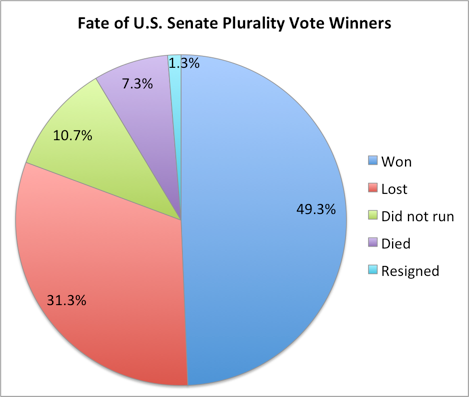On the Hot Seat: US Senate Plurality-Vote Winners
Nearly 40 percent of plurality vote winners of U.S. Senate contests lost their seat in the next election; three are on the ballot in 2014 (Begich, Franken, Merkley)

On the ballot in 2014 are three U.S. Senators who did not win the support of the majority of voters in their states.
The reelection prospects of two of them – Democrats Al Franken of Minnesota and Jeff Merkley of Oregon – are considered safe, for the moment, by most D.C. prognosticators.
The third – Alaska Democrat Mark Begich – is largely viewed to be in a dogfight against whichever candidate emerges as the GOP nominee from the deep red state.
The three incumbents – all in their first term – averaged 46.2 percent of the vote back in 2008, and represent states with extremely strong (Alaska, Minnesota) or moderately strong (Oregon) track records for independents and third party candidates.
In fact, Franken’s win with 42.0 percent over Norm Coleman is the 24th lowest level of support registered by a winning Senate candidate out of more than 1,680 popular vote races in U.S. history.
So can Franken, Begich, and Merkley all succeed again in 2014?
History suggests at least one will be in trouble.
A Smart Politics analysis finds that just 61 percent of plurality-vote winners of U.S. Senate races who ran for reelection won their subsequent contest and only 49 percent still held their seat at the start of the next term.
Since the first popular vote U.S. Senate contest in Oregon in 1906, a total of 160 races were won by a plurality vote.
(Note: This total does not include two special election plurality victories that were concurrently won by candidates on the same day as their plurality general election victories).
Of these 160 U.S. Senators, the fates of 10 are yet to be determined, as they are currently serving in the nation’s upper legislative chamber coming off a plurality vote win during one of the last three cycles.
Of the remaining 150 Senators, 121 ran for reelection to their seat, or 80.7 percent.
Sixteen Senators did not run for reelection (10.7 percent), 11 died in office (7.3 percent), and two resigned during their term (1.3 percent).
All told, just 49.3 percent of U.S. Senators who won without a majority of the vote still held their seat at the beginning of the next term (74 of 150).
Of the 121 Senators who ran for reelection, just 74 were successful, or 61.2 percent.
That makes 47 Senators who were not so fortunate and lost their seats, or 38.8 percent of those running, with 36 losing in the general election, nine losing their party’s nomination, one losing a contested election, and one not qualifying for his seat.
Over the last six cycles (2000-2012), only 13 of the 23 U.S. Senators who had notched a plurality victory in their previous contest were subsequently reelected to their seat (56 percent).
Six of these Senators lost their reelection bids:
· Minnesota Republican Rod Grams in 2000 (winning 49.1 percent in 1994).
· Virginia Democrat Chuck Robb in 2000 (45.6 percent in 1994).
· Georgia Democrat Max Cleland in 2002 (48.9 percent in 1996).
· New Hampshire Republican Bob Smith in 2002 (49.2 percent in 1996).
· Missouri Republican Jim Talent in 2006 (49.8 percent in 2002).
· Minnesota Republican Norm Coleman in 2008 (49.5 percent in 2002).
Three opted not to run for reelection:
· Minnesota Democrat Mark Dayton in 2006 (winning 48.8 percent in 2000).
· Connecticut Independent Democrat Joe Lieberman in 2012 (49.7 percent in 2006).
· Virginia Democrat Jim Webb in 2012 (49.6 percent in 2006).
And one resigned during his term:
· Florida Republican Mel Martinez in 2009 (49.4 percent in 2004).
That leaves just 13 Senators who went on to win another term:
· California Democrat Dianne Feinstein in 2000 (46.7 percent in 1994).
· Pennsylvania Republican Rick Santorum in 2000 (49.4 percent in 1994).
· Maine Republican Susan Collins in 2002 (49.2 percent in 1996).
· Montana Democrat Max Baucus in 2002 (49.6 percent in 1996).
· Oregon Republican Gordon Smith in 2002 (49.8 percent in 1996).
· Kentucky Republican Jim Bunning in 2004 (49.8 percent in 1998).
· Nevada Democrat Harry Reid in 2004 (47.9 percent in 1998).
· Michigan Democrat Debbie Stabenow in 2006 (49.5 percent in 2000).
· Washington Democrat Maria Cantwell in 2006 (49.5 percent in 2000).
· South Dakota Democrat Tim Johnson in 2008 (49.6 percent in 2002).
· Alaska Republican Lisa Murkowski in 2010 (48.6 percent in 2010).
· Missouri Democrat Claire McCaskill in 2012 (49.6 percent in 2006).
· Montana Democrat Jon Tester in 2012 (49.2 percent in 2006).
Meanwhile, the 2008, 2010, and 2012 cycles produced 10 sitting U.S. Senators winning with only a plurality of the vote.
Three will be on the ballot in 2014:
· Alaska Democrat Mark Begich: 47.8 percent in 2008.
· Minnesota Democrat Al Franken: 42.0 percent in 2008.
· Oregon Democrat Jeff Merkley: 48.9 percent in 2008.
Four are up for reelection in 2016:
· Alaska Republican Lisa Murkowski: 39.5 percent as a write-in candidate in 2010.
· Colorado Democrat Michael Bennet: 48.1 percent in 2010.
· Florida Republican Marco Rubio: 48.9 percent in 2010.
· Illinois Republican Mark Kirk: 48.0 percent in 2010.
Three are up for reelection in 2018:
· Arizona Republican Jeff Flake: 49.2 percent in 2012.
· Montana Democrat Jon Tester: 48.6 percent in 2012.
· Nevada Republican Dean Heller: 45.9 percent in 2012.
Other current Senators not mentioned above who have prevailed with plurality victories over their careers are Vermont Democrat Patrick Leahy (1974, 1980), Mississippi Republican Thad Cochran (1978), Kentucky Republican Mitch McConnell (1984), and California Democrat Barbara Boxer (1992).
In total, 23 sitting U.S. Senators have won at least one election with less than half of the vote.
The fact that Al Franken and Jeff Merkley will have to defend seats won without a majority of the vote is not unusual given the history of their respective states.
Minnesota leads the nation with 11 such plurality vote contests over the last century with Oregon in second with nine.
Plurality winners in the Gopher State are Republican Frank Kellogg (1916), Farmer-Laborite Henrik Shipstead (1922, 1934), Republican Thomas Schall (1924, 1930), Republican Guy Howard (1936 special), Republican Joseph Ball (1942), Republican Rod Grams (1994), Democrat Mark Dayton (2000), Republican Norm Coleman (2002), and Democrat Al Franken (2008).
In Oregon, Republican Jonathan Bourne (1906), Democrat George Chamberlain (1908, 1914), Democrat Harry Lane (1912), Republican Frederick Steiwer (1926), Republican Charles McNary (1936), Democrat Ron Wyden (1996, special), Republican Gordon Smith (1996), and Democrat Jeff Merkley (2008) all won contests without majority support of voters.
Connecticut, Nevada, and New York have each had eight contests with plurality winners followed by Colorado with seven, and California, Montana, and Wisconsin with six each.
Begich’s Alaska comes in with four since its first contest in 1958.
Eight states have yet to have a plurality vote winner: Alabama, Arkansas, Hawaii, Louisiana, South Carolina, Tennessee, West Virginia, and Wyoming.
Of the 110 plurality-vote winners who ran for another term and made it to the general election ballot received an average increase of 5.2 percentage points in the subsequent election – from 46.6 to 51.8 percent.
Follow Smart Politics on Twitter.

